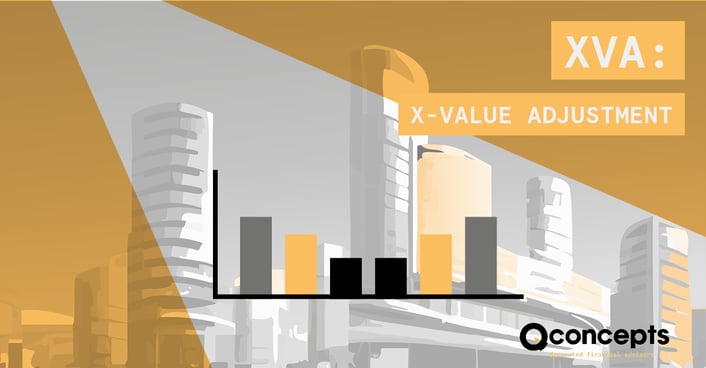Managing XVA risk is crucial for ensuring the stability and profitability of financial institutions in the dynamic banking world. XVA, or valuation adjustments, refers to a set of adjustments made to the fair value of derivative contracts to account for various risks, including credit, funding, and counterparty credit risks.These adjustments are becoming increasingly important, as banks face stricter regulatory requirements imposed by Basel IV, the fourth instalment of the Basel Accords. In this study, we explore the various XVA and CVA risks in particular. In addition, we discuss Basel IV changes and their implications.
The Evolution of XVA Risk
The concept of XVA risk emerged in the early 2000s as banks recognized the need to incorporate non-credit risks into the valuation of derivative portfolios. Traditionally, fair value was determined using models that assumed perfect creditworthiness and zero default risk, also known as the law of one price described by John Hull in his famous book Options, Futures, and Other Derivatives. However, as credit markets become more volatile, these assumptions become increasingly unrealistic.
The potential violation of the law of one price by XVA risk has implications for both pricing and risk management. In terms of pricing, this suggests that the fair value of a derivative contract may not be sufficient to capture all risks associated with the contract. Consequently, it may be necessary to incorporate XVA adjustments into pricing models to ensure that prices are accurate and reflect the true risks involved.
In terms of risk management, the XVA risk needs to be considered separately from the market risk of the underlying derivatives. This is because XVA risk can arise from factors that are not directly related to the market price of derivatives, such as the creditworthiness of counterparties and the liquidity of funding markets.
The 2008 financial crisis highlighted the importance of XVA risk management. The collapse of Lehman Brothers and the subsequent market turmoil exposed banks to significant losses due to counterparty defaults and funding/liquidity issues. Regulators and industry bodies have begun to develop standards for measuring and managing the XVA risk.
Identifying different XVA risks
XVA is a comprehensive framework that encompasses a set of derivative valuation adjustments designed to account for the various risks associated with over-the-counter (OTC) derivative transactions. The 'X' in XVA represents a collection of adjustments:
- Credit Value Adjustment (CVA): CVA is a measure of the credit risk associated with a derivative transaction. It represents the potential loss that a bank might incur if its counterparty defaults. By calculating CVA, financial institutions can assess the credit risk inherent in their derivative portfolios and incorporate this into their overall risk management strategies.
- Debit Value Adjustment (DVA): DVA reflects the potential gain that a bank may experience if its credit quality improves. It acknowledges that in certain cases, the bank may benefit from a reduction in the market value of its liabilities due to its improved creditworthiness.
- Funding Value Adjustment (FVA): This accounts for the cost of funding associated with maintaining the necessary capital to support derivative positions. It recognizes that holding capital against derivative transactions incurs funding costs, and FVA adjusts the valuation of derivatives accordingly.
- Capital Value Adjustment (KVA): KVA represents the cost of holding regulatory capital to support derivative trades. It considers the capital requirements imposed by regulatory bodies, and adjusts the valuation of derivatives to reflect the capital charges associated with maintaining these positions.
- Margin Value Adjustment (MVA): MVA captures the cost of posting initial and variation margins for non-cleared derivatives. As regulatory reforms, such as the implementation of central clearing requirements and reshaping the derivative landscape, MVA has become increasingly important in assessing the true cost of maintaining derivative portfolios.
CVA risk: the most important XVA
CVA is a measure of the additional loss that a bank may incur in an OTC derivative transaction if its counterparty defaults. This loss can arise from a variety of factors such as the unwinding of the derivative position at a loss, the potential for legal action, and the costs associated with bankruptcy proceedings.
The CVA is calculated based on several factors, including
- The creditworthiness of the counterparty: The lower the counterparty's creditworthiness, the higher the CVA, as the bank is more likely to incur losses in the event of a default.
- The term of the derivative contract: the longer the term of the contract, the higher the CVA, as the bank's exposure to the counterparty's credit risk extends for a longer period.
- Credit spreads: The higher the credit spreads in the market, the higher the CVA, as banks are willing to pay more to compensate for the risk of default.
- Liquidity of the derivative contract: Illiquid contracts may have higher CVAs because the bank may face difficulty finding alternative counterparties in the event of the counterparty's default.
- Underlying asset volatility: Higher volatility in the underlying asset may lead to higher CVAs as the bank's exposure to the counterparty's credit risk increases during periods of heightened market volatility.
Several possibilities exist in practice to determine CVA. Unilateral and bilateral CVA are differentiated. In the first case, the bank considers only the counterparty’s creditworthiness. However, in the bilateral approach, banks’ default risk is included. Only a unilateral approach can be used for regulatory purposes. CVA can be determined at the portfolio, counterparty, netting-set, or individual transaction levels.
Basel IV implications
The current CVA framework according to the CRR allows for two methods to determine the CVA risk capital charge: the advanced method with supervisory approval and standardized approval. Both methods are designed such that only the credit spread risk of the counterparty is considered as the sole driver of CVA risk.
The revised framework pursuant to CRR 3 consists of two subframeworks (SA-CVA and BA CVA) and a simplified approach. The Standard Approach (SA-CVA) is designed for banks to calculate CVA sensitivities to various risk factors and requires supervisory approval. The Basic Approach (BA-CVA) builds further upon the current standard model, and the simplified model can only be applied if the off-balance sheet derivatives business is below 5% of the total assets and is not deemed material.
The Basel Committee pursues the following goals within the new CVA framework:
- Enhance risk sensitivity by including the variability of the exposure component.
- Strengthen robustness: The new framework does not include an internal model approach.
- Improve its consistency: more closely align with capital charges for market risk.
In addition to OTC derivatives also SFT (Securities Financing Transactions (SFTs) are to be included in the calculation of the own fund’s requirement if the CVA risk is determined material.
Regarding the existing exemptions for the CVA calculation, Article 382(4) CRR 3 does not provide any changes. The following transactions are still not considered in the CVA risk calculation:
- • Centrally cleared trades via a Qualified central counterparty.
- Intra-group transactions.
- Pension funds.
- Transactions with non-financial counterparties ( not subject to an EMIR obligation)
- Central banks and Governments.
Nevertheless, articles 382 (4a and 4b) in CRR 3 introduce a new provision requiring institutions to report the results of the calculation of their own funds requirement for CVA risk for exempted transactions.
In response to the Basel IV changes, banks have adopted a range of strategies to manage CVA risk effectively:
- Improving CVA Modeling: Banks have invested in refining their CVA models to incorporate the complexities of Basel IV requirements and to better reflect their idiosyncratic risk profiles. This includes incorporating more granular data on counterparty creditworthiness and market conditions.
- Optimizing Collateral Management: Banks have enhanced their collateral management processes to ensure timely and efficient collateral posting, minimizing the risk of margin calls and potential CVA losses. This includes optimizing collateral allocation across different counterparties and asset classes.
- Hedging CVA Exposure: Banks have explored hedging strategies to mitigate their CVA exposure, such as using credit derivatives or entering into offsetting OTC derivative transactions. These strategies can help to reduce CVA volatility and enhance risk management.
By more accurately calculating CVA, banks can better manage their counterparty credit risk, improving their overall risk profile and enhance their risk management.
Summary
As BASEL IV reshapes the regulatory landscape for banks, the calculation and management of XVA for OTC derivatives will undergo significant changes. Financial institutions must adapt to new requirements, invest in technology and data infrastructure, and enhance risk management practices.
The future of XVA under BASEL IV holds both challenges and opportunities. While compliance with new requirements may increase costs and complexity, it also provides an opportunity for financial institutions to strengthen their risk management frameworks and improve the accuracy of XVA calculations.
Lees de volledige serie artikelen:
1. BASEL IV: A game changer?
2. Risk-Weighted Assets: Levelling the playing field?
3. Basel IV and Clearing: A clearer picture
4. Basel IV and Securities Financing Transactions (SFT)
5. Cleared Repo: A clearer view on Repos?
6. CCP: Insights of a Master Machine
7. The Euro System Collateral Management System
8. Climate Risk, the facts and the trends
9. How to Risk Manage Climate Risk: Looking for a Crystal ball
10. XVA: X-Value Adjustment







